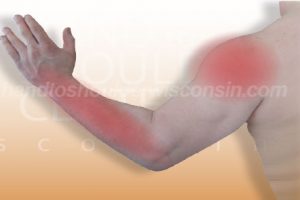Are you concerned that you may have tendonitis of the hand, finger, wrist, elbow, or shoulder? The orthopedic doctors and staff at Hand to Shoulder Center of Wisconsin have experience in diagnosing tendonitis, as well as providing various treatment options. Contact us today if you believe you’re experiencing symptoms of tendonitis.
What is Tendonitis?

Figure 1: Tendons of the arm affected by tendonitis
Tendonitis, is a painful condition of tendon irritation. Tendons are located throughout the whole body. They are flexible, rope-like tissue that connects muscle to bone. When upper extremity tendons become inflamed and irritated, symptoms such as pain and stiffness may be present (Fig. 1). In many cases, overuse can be a causative factor causing inflammation which over time can lead to tears in the tendon.
Tenosynovitis, unlike tendonitis, is an inflammation of the lining of the tendon sheaths that surrounds the tendons. Pain can be caused by motion of the tendon within the sheath. DeQuervain’s tenosynovitis is a common condition that affects the tendons at the base of the thumb and wrist. Over use and injuries can also precipitate symptoms. Systemic diseases, such as diabetes or rheumatoid arthritis may also play a factor in the development of tenosynovitis.
At Hand to Shoulder Center of Wisconsin, our orthopedic physicians commonly treat tendon conditions. This includes:
- Tennis elbow
- Tendon ruptures
- Tendon lacerations
- Tenosynovitis such deQuervain’s tenosynovitis and trigger finger/thumb
- Shoulder/rotator cuff/bicep tendonitis
Tendonitis can occur at any age; however, with the wear and tear of aging, muscles and tendon lose some of their elasticity, making the tendons more susceptible to the development of tendonitis. Athletes and individuals that perform excessive repetitive movements tend to be more at risk of developing tendonitis.
Symptoms of Tendonitis
Although symptoms vary from person to person, the most common symptoms of tendonitis are inflammation, swelling and pain with movement. Additional symptoms may include weakness in the joint area.
Diagnosis and Tendonitis Treatment
In diagnosing tendonitis, or tenosynovitis, our subspecialty-trained orthopedic surgeons will conduct a thorough examination. Review of medical history will be discussed along with a physical examination.
In most cases, tendonitis or tenosynovitis can be confirmed on the physician’s examination. X-rays may be ordered to rule out other conditions. Lab work and/or imaging testing, such as an ultrasound or MRI (magnetic resonance imaging) may also be ordered to rule out other conditions and diseases.
Treatment options for tendonitis may include:
- Occupational/physical therapy
- Ice, rest and modification of movements
- Anti-inflammatory medication
- Splinting or immobilization
- Steroid injections
- Surgery